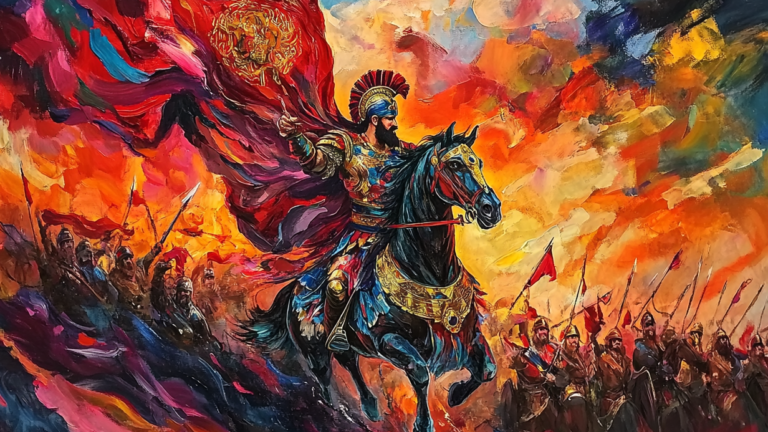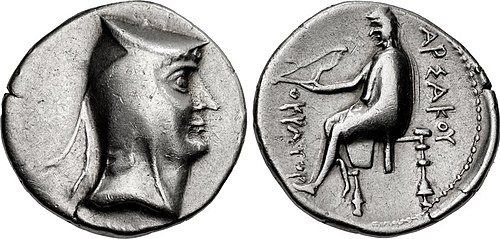Xerxes I "Persia's Defining Ruler"
Xerxes I of Persia , who reigned from 486 BC to 465 BC, is one of the most renowned rulers of the Persian Empire. After the death of his father, Darius I, Xerxes ascended to the throne, leaving behind not only military triumphs but also a legacy defined by his governance and cultural perspectives. His reign marked the peak of the Persian Empire’s expansion efforts toward the West, which included significant wars and various reforms. In this article, we will examine Xerxes I in depth, discussing the key events of his era, his personality, military strategies, and legacy.

King Xerxes I took the throne after the death of his father, Darius I, at a time when the Persian Empire was a vast and powerful entity. Darius, in his reign, had achieved great military victories and expanded the empire’s borders. However, for Xerxes, ascending to the throne meant more than just continuing his father’s legacy. Xerxes began to shape his own vision of empire governance.
Xerxes I’s administrative approach was more centralized compared to his predecessors. To manage the vast Persian Empire more efficiently, he sought to limit the autonomy of regional governors, thereby reinforcing the central government’s power. This move consolidated Xerxes’ direct control over various regions of the empire. At the same time, he implemented a series of reforms to unify the diverse peoples within the empire.

King Xerxes I’s major projects included grand construction efforts in the capitals of Susa and other Persian cities. The Persepolis palace is one of the most notable symbols of his reign. Xerxes turned Persepolis into a major cultural center, where he hosted lavish ceremonies and celebrations. These projects not only strengthened his military power but also contributed to the cultural and artistic heritage of the empire.
Xerxes I fought the greatest battle to expand the Persian Empire, but he also brought about the greatest losses for that empire.
Herodotus Tweet
Xerxes and the Great Campaign Against Greece
One of the most significant events of Xerxes I’s reign was his great campaign against Greece. The year 480 BC was a turning point for the Persian Empire. Xerxes, building on his father Darius I‘s efforts, launched a massive invasion of the Greek city-states, seeking to conquer them and expand Persian influence further into the West. This campaign was not just a military conflict but also a cultural clash, with the East and West locked in a struggle for dominance.
Xerxes I’s campaign against Greece involved two major battles: the Battle of Thermopylae and the Battle of Salamis. At Thermopylae, the famous stand of Leonidas and his 300 Spartan warriors against the overwhelming Persian forces became legendary. This battle temporarily halted the Persian advance, but King Xerxes I continued his invasion with an even larger army and navy.
The subsequent Battle of Salamis resulted in a decisive defeat for the Persian navy. The Greek fleet, using superior tactics, destroyed Xerxes’ forces, preventing further Persian expansion into Greece. This defeat marked the end of the Persian Empire’s Western campaign and a major setback for King Xerxes I. Despite the vast resources and power at his disposal, Xerxes I’s Greek campaign ultimately failed, preserving the independence of the Greek city-states and allowing Western civilization to flourish.

King Xerxes I's Cultural and Religious Policy
Another key aspect of King Xerxes I’s reign was his cultural and religious policy. Zoroastrianism was the state religion of the Persian Empire, and Xerxes I supported the faith while also maintaining a degree of religious tolerance throughout his empire. Xerxes I allowed various religious and cultural practices to coexist within the vast territories he governed, reflecting the pluralistic nature of the empire.
However, Xerxes I’s reign was not solely defined by religious tolerance. Xerxes I’s antagonism toward the Greek territories was also a part of his effort to assert Persian cultural superiority over the West. Despite these tensions, his reign led to the preservation of Persian cultural values, and his monumental construction projects served to project the grandeur of the Persian Empire.

The Decline of Xerxes I and Aftermath
The final years of Xerxes’ reign were marked by military failures and political unrest. After the defeat at Salamis, Xerxes’ attempts to push further into Greek territory were thwarted, and his empire began to experience internal strife. Historical accounts suggest that in his later years, Xerxes became melancholic, turning toward indulgence and excess, which led to dissatisfaction among the Persian populace.
Xerxes I was born to be an emperor, yet his defeat in Greece shattered his belief in victory.
Sulla Tweet
After Xerxes I’s death, his son Artaxerxes I ascended the throne and attempted to stabilize and reform the empire. However, Xerxes I’s death marked the end of the Persian Empire’s ambitions in the West. The failures of his military campaigns and internal instability left a legacy that shaped the future of the empire. Despite these setbacks, the monumental buildings and cultural projects initiated by Xerxes I continued to symbolize the glory of the Persian Empire.


![Coin of Arsaces I. The reverse shows a seated archer carrying a bow, with the Greek legend reading "ΑΡΣΑΚΟΥ" (right) and "[AYT]OKPATOP[OΣ]" (left), meaning [coin of] "Arsaces"](https://historifyproduction.com/wp-content/uploads/2025/04/500px-Coin_of_Arsaces_I_1_Nisa-1-150x150.png)



